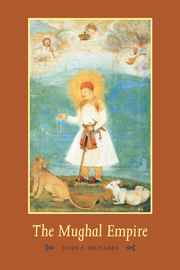Book contents
- Frontmatter
- Contents
- List of maps and tables
- General editor's preface
- Preface
- Introduction
- 1 Conquest and stability
- 2 The new empire
- 3 Autocratic centralism
- 4 Land revenue and rural society
- 5 Jahangir 1605–1627
- 6 Shah Jahan 1628–1658
- 7 The War of Succession
- 8 Imperial expansion under Aurangzeb 1658–1689
- 9 The economy, societal change, and international trade
- 10 Maratha insurgency and Mughal conquest in the Deccan
- 11 The Deccan Wars
- 12 Imperial decline and collapse, 1707–1720
- Conclusion
- Glossary
- Bibliographic essay
- Index
- THE NEW CAMBRIDGE HISTORY OF INDIA
11 - The Deccan Wars
Published online by Cambridge University Press: 28 March 2012
- Frontmatter
- Contents
- List of maps and tables
- General editor's preface
- Preface
- Introduction
- 1 Conquest and stability
- 2 The new empire
- 3 Autocratic centralism
- 4 Land revenue and rural society
- 5 Jahangir 1605–1627
- 6 Shah Jahan 1628–1658
- 7 The War of Succession
- 8 Imperial expansion under Aurangzeb 1658–1689
- 9 The economy, societal change, and international trade
- 10 Maratha insurgency and Mughal conquest in the Deccan
- 11 The Deccan Wars
- 12 Imperial decline and collapse, 1707–1720
- Conclusion
- Glossary
- Bibliographic essay
- Index
- THE NEW CAMBRIDGE HISTORY OF INDIA
Summary
Aurangzeb's triple victory – Bijapur, Golconda, and the Maratha kingdom – should have been the prelude to a new era of peace, prosperity, and political stability in the Deccan and southern India. With the exception of the Tamil regions of the Golconda and Bijapur Karnatak, but recently conquered in the 1640s, the western Deccan of the Marathas and the eastern Deccan of the Telugus had long been accustomed to Indo-Muslim rule. After a brief period of overseeing initial arrangements, the emperor would lead his grand encampment and central army triumphantly north back to Shahjahanabad. As they had dozens of times in the past cadres of imperial administrators could assume those powers exercised by their defeated counterparts in each of the three kingdoms. Surplus revenues from the new provinces would flow northward to enrich treasuries in Delhi and Agra. Instead, the reverse occurred. Aurangzeb remained in the Deccan, year after year, fighting an endless war and hoping to reverse a descending spiral of public order and imperial power in that region.
The insurgent Maratha state did not die with Shambhaji. His younger brother Rajaram, hastily crowned, fled to the extreme south to take refuge in Jinji fortress. Maratha officers left in the north directed an intensifying campaign of predatory raiding against the Mughals. Imperial officials faced enormous difficulties in defending their districts and in collecting revenues.
- Type
- Chapter
- Information
- The Mughal Empire , pp. 225 - 252Publisher: Cambridge University PressPrint publication year: 1993

